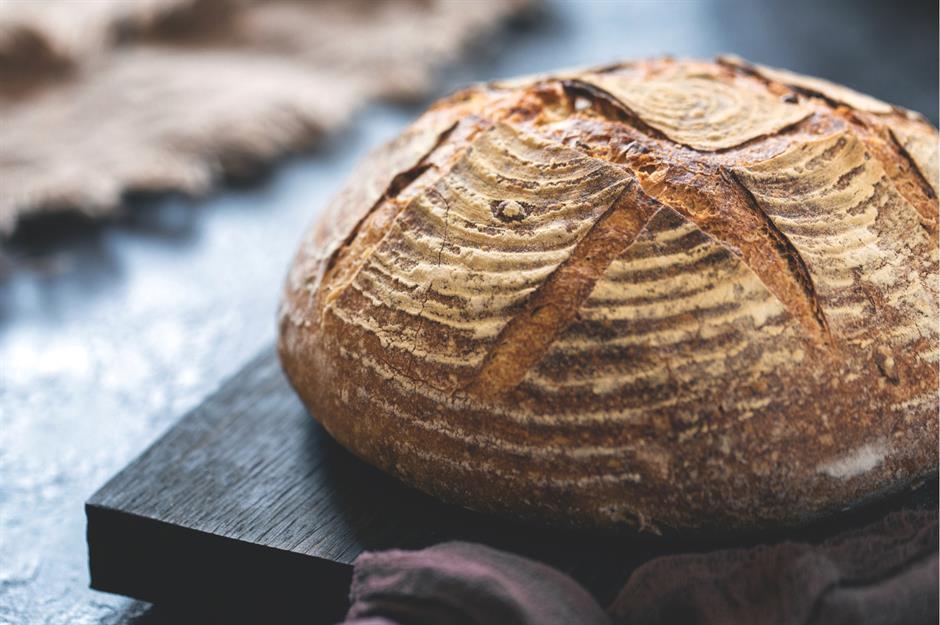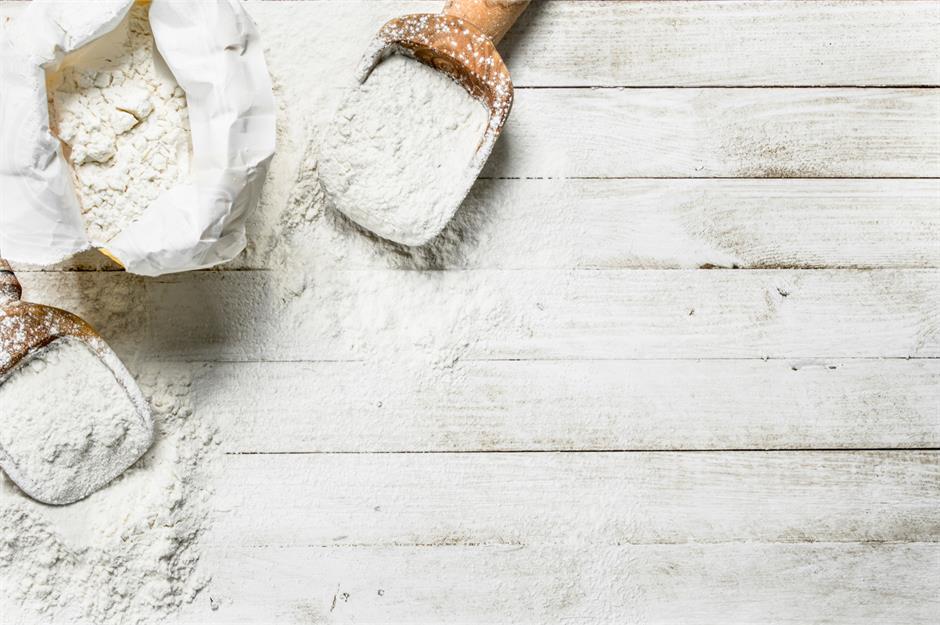30 brilliant home-baked bread tips
The power of flour
Getting started: know your flours
Strong flour, or strong bread flour, is made from hard wheat varieties. It contains more gluten than other types of flour, which gives it its elasticity and ensures the dough rises with a good structure. If you can, it's worth tracking down Canadian strong flour, which contains a higher gluten content to give you the best loaf. After all, basic bread is just flour, yeast, salt and water, so your flour is very important.
Getting started: give spelt a go
High-fibre spelt has been cultivated for thousands of years and has recently been making a comeback. As a flour for baking, the gluten breaks down more easily than wheat flour so use spelt in a bread which you don't have to knead. For example, it works very well in a soda bread.
Get the recipe for soda bread-style focaccia here and substitute the plain flour for spelt
Getting started: try wholemeal for a healthier loaf
Getting started: what about rye flour?
Rye is actually a grass but it's related to wheat. It does contain some gluten but produces a heavy, sticky dough which takes longer to rise than strong white flour. However, the flavour more than makes up for it. It's earthy and chewy and perfect for crisp breads topped with gravadlax or cream cheese, salami and pickles.
Getting started: dried vs fresh yeast
Getting started: sourdough starters
A sourdough starter, or a levain, is simply a mix of flour (usually half white and half wholemeal) and water. It's then left to allow the natural wild yeasts and bacteria in the flour and the air to thrive and multiply. This 'mother dough' is added to your bread recipe and acts as a natural yeast. This is why the flavour of sourdough is different to a loaf made with commercial yeast. The starter varies according to the weather and your location.
Getting started: the right kit
Top tips: the need to knead
Top tips: the jargon buster
Top tips: unbeatable baguettes
When you're confident in your bread skills, why not have a go at a classic French baguette? Meaning stick, the recipe and size are set in French law. A baguette is made with a starter dough the day before, similar to the idea behind sourdough. To achieve the quintessential shape, you need what's called a baker's couche, or cloth (pictured). But you can improvise by using a large, heavily floured tea towel. Baguettes are baked in a hot oven with steam, so pop a roasting tin of water in your oven to mimic the effect.
Top tips: working with rye
Top tips: going gluten-free
Now you can buy gluten-free flour, bread-making for coeliacs is much simpler. You can't replicate bread made with wheat flour because the gluten helps the bread to rise, but at least there's the option. The only problem is that gluten-free bread doesn't keep well as it goes hard quite quickly. But you can freeze it, or better still, slice then freeze and use it for toast.
Top tips: pimp your burger
Once you've mastered bread dough, burger buns are just as simple. When dividing up the dough, use a floured pizza cutter and weigh the dough balls on a digital scale so they are uniform. You can freeze them once baked, then wrap in foil to reheat in a medium oven for about 10 minutes.
Top tips: mix salt and yeast gradually
You'll notice some recipes ask you to add the salt and yeast in separate sides of the bowl. It's because salt inhibits the fermentation of the yeast which helps the dough to rise. However, salt does help the gluten to develop and become elastic and stretchy.
Top tips: nail that crust
Top tips: learn from any mistakes
Here are some easy fixes for common problems. The loaf has holes in the middle? You under-kneaded it. The loaf is dense and dry? You over-kneaded it. The loaf is dry and crumbly? You fell into the trap of adding too much flour. Remember dough is sticky when you start so persevere and be patient. The loaf is soft and gooey in the middle? Underbaked. Tap the base of your loaf and it should sound hollow. If in doubt, cook a little further. The loaf is hard to slice? You probably couldn't resist slicing it straight from the oven!
Recipe: cornbread
Cornbread is a humble food with no yeast – the raising agent is bicarbonate of soda (baking soda) combined with buttermilk. No buttermilk? Add a good squeeze of lemon juice to skimmed milk and leave for 20 minutes. It's quick to make and if you have leftovers, sprinkle over water then blast in a hot oven for five minutes or so.
Recipe: enriched dough
An enriched dough is one containing eggs and butter. Brioche and cinnamon buns are a couple of styles of enriched dough. It's best to use an electric mixer as you incorporate a lot of butter. These doughs take longer to rise because of the fat content, around two to three hours.
Recipe: soda bread
A traditional Irish soda bread is super quick to make as there's no yeast used. The trick is to barely knead it or your loaf will be tough. It's just flour, buttermilk and bicarbonate of soda (baking soda), usually with a little treacle added. It's best to make it on the day you want it, although leftovers make perfect toast.
Recipe: focaccia
Focaccia is a flat-ish Italian bread flavoured with olive oil, sea salt and fresh herbs. It's a perfect bread to make for an antipasti sharing platter. You can add your own toppings – try pitted olives, seedless grapes or rosemary – or incorporate fillings in the dough, like tangy cheese or walnuts. Don't skimp on the salt in any bread recipe as without it, your bread will be bland.
Get the recipe for classic oregano and sea salt focaccia here
Recipe: gluten-free focaccia
You don't have to miss out on fabulous focaccia if you have a gluten intolerance. Use a blend of flours like tapioca, cornflour, potato flour and soya flour. Even better, you can use the same mix to create your own gluten-free pizzas.
Recipe: chapatti
Almost every culture has a flatbread of some description. They are the simplest mix of flour, water and salt. Some are leavened (yeasted), such as pitta; some are not, such as Indian roti. Chapatti are made with a special flour called atta but you could use a half-and-half mix of plain and whole-wheat flour. Use the flatbreads to scoop up curries or as wraps.
Recipe: ciabatta
We love ciabatta with its floury crust and airy interior. It's easier to make than you would think, so put that supermarket loaf down. You really need an electric hand whisk or mixer as the dough is quite wet – it's what gives the bread that characteristic open texture. Some recipes use a starter dough which you need to leave for 24 hours, so plan ahead. The slow fermentation of the starter gives it the traditional acidic tang.
Recipe: perfect pizzas
Pizza is just a bread dough and yet another flatbread we've come to love. Homemade is far superior to a takeaway and a fun thing to make with kids who can design their own pizza toppings. Our top tip? Allow the dough to rise really slowly for 24 hours in the fridge. This helps to give you that sourdough flavour.
Recipe: breakfast bread
Recipe: spiced breadsticks
Store-bought breadsticks tend to be bland and dull, and you could do so much more with them. Try adding spices like garam masala and cumin, or dried basil, poppy seeds and grated Parmesan. You can bake then freeze to have breadsticks on standby – just flash in a hot oven to reheat.
Recipe: plaited loaf
A plaited, or braided, bread is a thing of simple beauty. Breads are often plaited for special occasions, and the amount of strands and shape are symbolic. To make, simply divide the dough into the amount of strands you need and stick them together at the top, then start braiding or plaiting.
Recipe: bagels
If ever there was a difference between shop-bought and homemade, it's in a bagel. The technique which gives bagels that chewy crust and dense exterior is in the boiling, or poaching of the dough, before you bake the bagels. But this is a very brief process so do time it accurately. Over-boiled bagels are tough, rather than chewy.
Recipe: super-seedy bread
Everyone loves seeded bread and you can add any seeds of your choice to your favourite recipe. Try pumpkin, flaxseed, sesame or even nuts which means you're also adding healthy omega-3 fatty acids and fibre to your loaf. And wow, does it make great toast.
Recipe: simple sourdough
Let's face it – buying a sourdough loaf from a bakery costs a fortune, especially given that it's just flour and water. The expensive element is your time but luckily most of it isn't hands on. You'll need a few attempts to get it right as the sourdough will vary depending on the weather and the temperature but it's a great cooking project to get stuck into.
Find more tips for making sourdough in our complete bread-making guide

